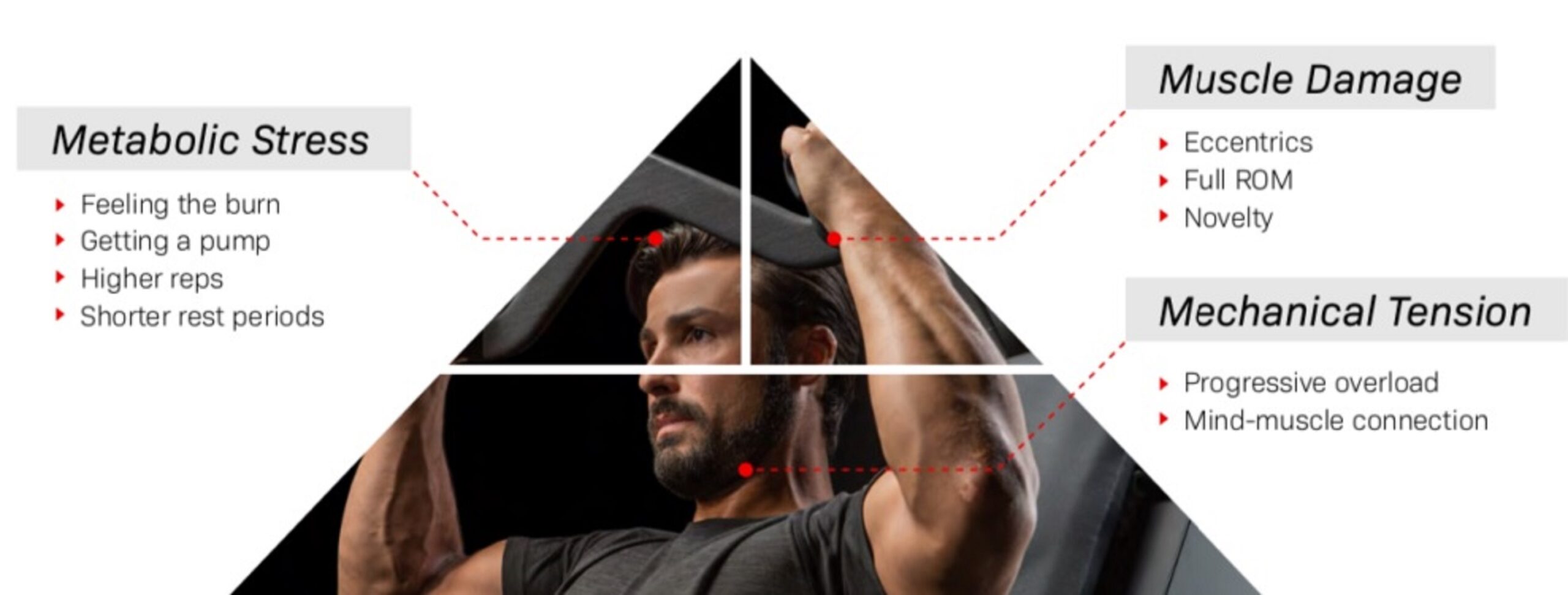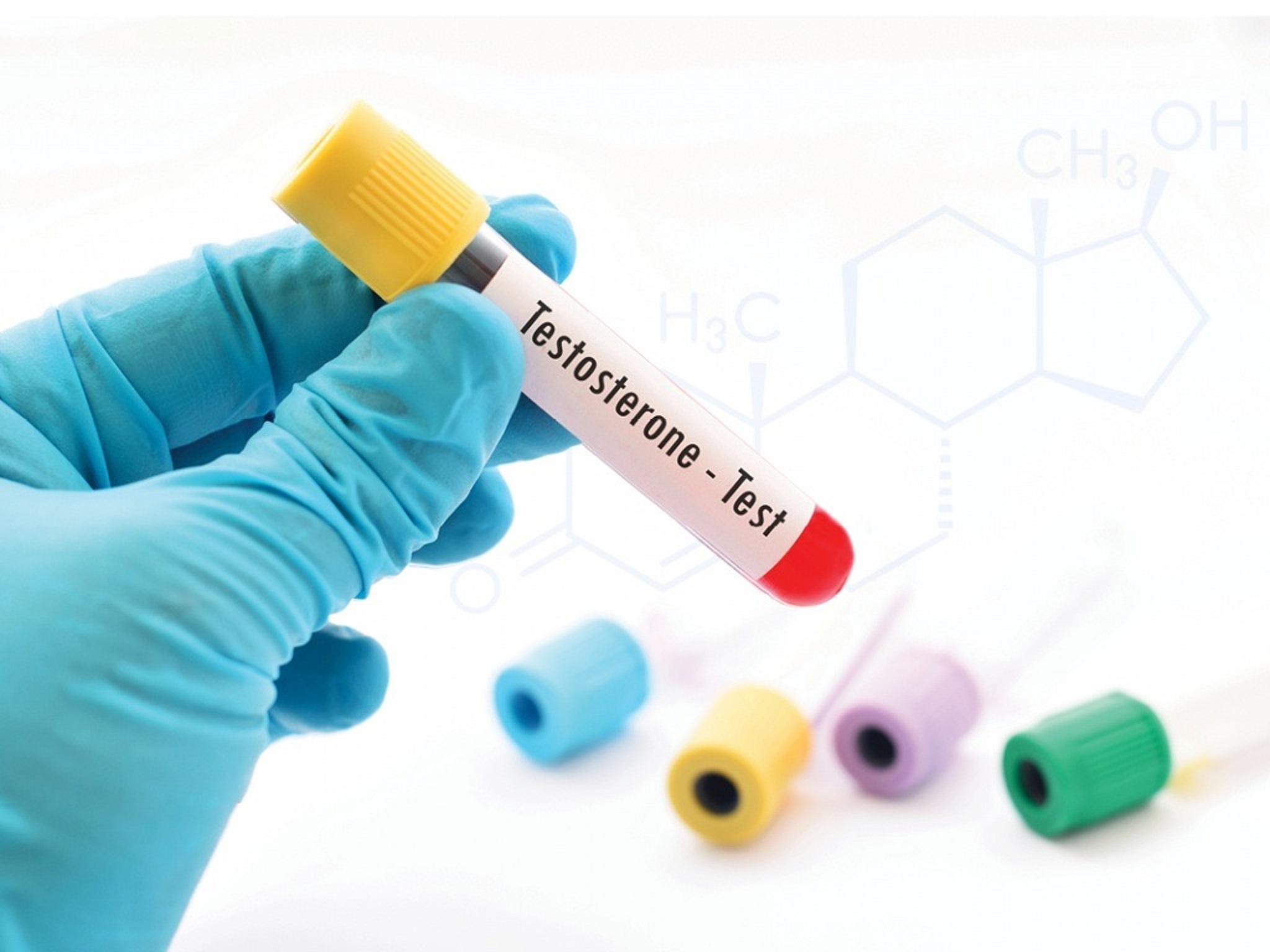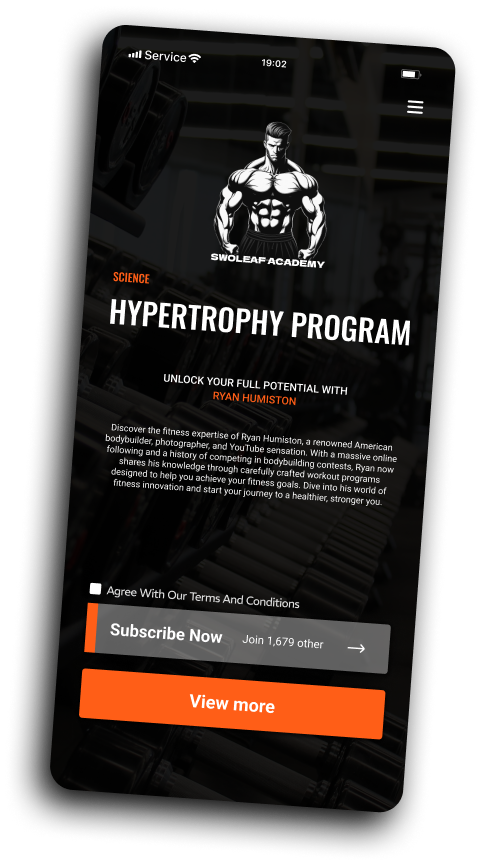Today, we embark on the exploration of a question that stirs passionate debates within the fitness community: Is muscle soreness a reliable indicator of growth? It is, though not in the straightforward manner you might expect. Let’s delve into the intricacies.
The Three Pillars of Growth
Let’s delve into the concept of muscle soreness as an indicator of muscle growth and explore the three primary mechanisms of growth: mechanical tension, metabolic stress, and muscle damage.
- Mechanical Tension (Progressive Overload): This mechanism involves progressively overloading your muscles over time. As you lift heavier weights or increase resistance, you create tension in the muscle fibers, prompting them to adapt and grow.
- Metabolic Stress (Constant Tension): This mechanism is characterized by maintaining tension on the muscles throughout the exercise, often achieved through slow, controlled movements and higher rep ranges. Metabolic stress creates an environment where metabolites accumulate in the muscle, contributing to muscle growth.
- Muscle Damage (Muscle Soreness): This mechanism is associated with the micro-tears that occur in muscle fibers during intense exercise, leading to soreness in the days following the workout. The body repairs these micro-tears, resulting in muscle growth.
The Contention: Soreness vs. Growth
- The crux of the debate arises from the assertion that soreness doesn’t have to be a constant companion for muscle growth to occur.
- One can pursue the path of mechanical tension or metabolic stress and experience substantial growth with minimal soreness. This distinction fuels fervent debates, with some passionately proclaiming, “Soreness does not equal growth!”
- However, it’s essential to recognize that these three mechanisms aren’t locked in an either-or battle.

- It’s not a rigid choice between mechanical tension and metabolic stress. Instead, it’s a dynamic interplay where growth can manifest through various avenues, each with its unique characteristics.
The Science of Muscle Soreness
- Now, let’s address a fascinating aspect of the muscle soreness saga. Even within the scientific community, there’s a lack of unanimous agreement on the nature of muscle soreness.
- Picture this: scientists conducting studies that involve electrocuting individuals to unravel the mysteries of soreness.
- One year, they attribute it to muscle fibers, the next, they suspect connective tissue, and then there’s the suggestion that it might be linked to inflammation.
- Yet, here’s the twist – the ongoing debate among scientists doesn’t necessarily alter the practical significance of muscle soreness in your fitness journey. In the grand scheme, the intricacies of whether it’s fibers or connective tissue are less crucial than the role muscle soreness plays in guiding your training approach.
Practical Significance in Training Philosophy
- In this less-than-harmonious three-horse race, the key decision lies in your training philosophy.
- Are you leaning towards the camp of mechanical tension, prioritizing progressive overload? Or do you find solace in the realm of metabolic stress, reveling in constant tension during your workouts?

- The choice between these isn’t a trivial matter, and muscle soreness emerges as a vital measuring stick to guide your decision-making.
- So, while the scientific community engages in its debates, your focus can remain on the practical application of this feedback loop. Whether muscle soreness is a result of fibers, connective tissue, or inflammation, its presence becomes your compass, guiding you through the intricacies of your training journey.
Decoding Muscle Soreness
The rationale behind the assertion that muscle soreness equates to growth lies in viewing it as an intricate feedback loop integral to the muscle-building process. Let us elaborate on this perspective.
Indicator of Effective Muscle Targeting
- Consider soreness as a tangible indicator of whether you’ve effectively targeted the intended muscle group.
- Picture this: you aimed to engage your traps, and the following morning, you experience an unpleasant ache in an unexpected region. This discomfort signals a misfire in your workout strategy; you missed the mark. Soreness, therefore, acts as a discerning guide, offering insights into the precision of your muscle targeting.

Metric for Assessing Training Intensity
- Moreover, soreness serves as an invaluable metric for assessing training intensity. Whether you align with the philosophy of constant tension or progressive overload, the aftermath of your leg day speaks volumes.
- If, after training legs, you wake up the next day feeling spry and ready for a repeat performance, it’s a sign that you might not have pushed yourself to the brink during your initial session.
- A logbook is unnecessary to confirm that the absence of lingering soreness indicates a less-than-optimal level of effort.
Balancing Act: Pursuit vs. Caution
- Now, some voices caution against actively pursuing excessive soreness, positing that it could compromise subsequent performance.
- The argument suggests that too much soreness might impede your ability to bring your A-game to the next workout.
- While there’s merit in this viewpoint, it’s crucial to underscore the adaptability of the human body. Rather than shying away from soreness, consider it a temporary state, a reminder that you’ve stretched your limits.
- Over time, your body adapts, and what once induced significant soreness becomes a routine part of your journey toward greater strength and endurance.
A Balancing Act for Optimal Growth
The discussion about muscle soreness extends beyond its presence to the subsequent inquiries: How do you navigate training when still sore, and is it advisable to actively reduce soreness? Let’s break down these considerations.
Scheduling and Adaptation:
- Firstly, the issue of scheduling arises. If you have your trained legs on Thursday and find yourself still sore by Tuesday, a potential performance dip looms.
- However, this assumes an inability to adjust your schedule—a presumption better suited for a four-year-old than a seasoned fitness enthusiast.
- The idea here is that you earn the right to rest more, allowing your body the necessary time to adapt. Over time, as your body becomes accustomed to the demands placed on it, the need for extended rest periods diminishes.
The Pitfall of Active Soreness Reduction
- Yet, avoiding soreness altogether isn’t the solution. The subsequent question often centers on how to reduce soreness.
- Here’s where the conventional approach can be counterproductive. Turning to anti-inflammatories or other interventions aimed at curbing inflammation might seem like a logical step to alleviate discomfort.
- However, this approach has a potential drawback—it interferes with the natural adaptive process crucial for muscle growth.
Embracing Soreness as a Growth Signal
- When you engage in intense workouts, you’re essentially subjecting your muscles to controlled stress, prompting adaptation and growth.
- Seeking to immediately dampen the inflammation through external means could thwart this process. By suppressing the body’s response to stress, you might inadvertently hinder the very mechanism driving muscle development.
The Significance of Soreness
- Soreness functions as a benchmark for gauging the intensity of a training session. The discomfort you experience post-workout is a tangible reminder that you’ve pushed your body beyond its accustomed limits.
- This intensity is a crucial component of progressive overload, a fundamental principle driving muscle adaptation and growth over time.
- Lastly, soreness plays a pivotal role in the recovery process. The discomfort underscores the need for adequate rest and recuperation between workouts.
- Acknowledging the importance of recovery ensures that you strike a balance between challenging your body and providing it with the necessary resources to rebuild and grow stronger.
Prolonged Soreness: Insights from Blood Work
The prolonged soreness lasting for weeks on end can indeed be a red flag signaling potential internal issues. If you find yourself in a state of persistent soreness, it’s advisable to consider the broader spectrum of factors influencing your recovery and overall well-being. In such cases, obtaining comprehensive blood work becomes a prudent step to delve into the underlying issues.
Hormonal Balance Insights
- Blood work serves as a comprehensive tool, offering crucial insights into multiple markers, encompassing hormonal balance, nutritional deficiencies, and overall health status.
- Hormones, such as cortisol and testosterone, assume pivotal roles in the body’s recovery and adaptation processes. Disturbances in these hormonal levels can significantly influence the capacity to recuperate effectively from strenuous workouts.

- Cortisol, often referred to as the stress hormone, can rise during periods of intense physical activity or chronic stress, potentially impeding recovery. On the other hand, optimal testosterone levels are essential for muscle repair and growth.
- By conducting thorough blood work, individuals can pinpoint and address hormonal imbalances, ensuring a more informed and targeted approach to enhancing recovery and overall well-being.
- This proactive stance promotes a comprehensive understanding of the body’s internal dynamics, facilitating tailored strategies for improved fitness outcomes.
Nutritional Deficiency Identification
- Nutritional deficiencies, particularly a lack of essential vitamins and minerals, can significantly hinder the recovery process and contribute to prolonged muscle soreness.

- Conducting a thorough assessment of blood markers allows for the identification and rectification of any deficiencies, ensuring that the body receives the necessary nutrients critical for achieving optimal recovery.
- Adequate levels of vitamins and minerals play a pivotal role in various physiological processes, including tissue repair and immune function. Therefore, addressing nutritional gaps can be instrumental in promoting a more effective and efficient recovery period.
- This proactive approach not only facilitates faster recovery from physical exertion but also supports overall well-being by promoting a balanced and nourished internal environment.
Indicators of Overtraining or Stress
- Additionally, enduring muscle soreness may signal overtraining or insufficient rest within your fitness regimen.
- Blood work becomes a valuable tool in unveiling insights into overall stress levels, enabling informed decisions regarding adjustments to training volume, intensity, or the integration of additional rest days into the routine.
- Armed with this knowledge, one can strategically modify their exercise routine, optimizing the balance between exertion and recovery. This proactive approach not only fosters better physical well-being but also enhances the efficacy of training efforts, ultimately promoting sustainable and long-term fitness success.









